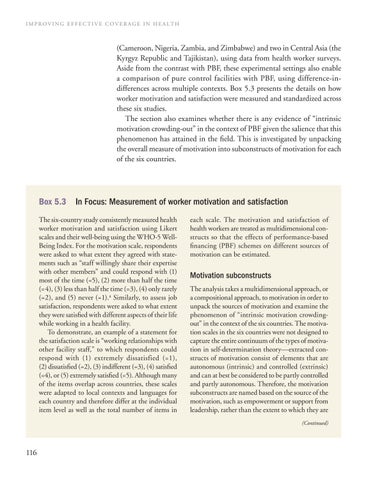IMPROVING EFFECTIVE COVERAGE IN HEALTH
(Cameroon, Nigeria, Zambia, and Zimbabwe) and two in Central Asia (the Kyrgyz Republic and Tajikistan), using data from health worker surveys. Aside from the contrast with PBF, these experimental settings also enable a comparison of pure control facilities with PBF, using difference-in- differences across multiple c ontexts. Box 5.3 presents the details on how worker motivation and s atisfaction were measured and standardized across these six studies. The section also examines whether there is any evidence of “intrinsic motivation crowding-out” in the context of PBF given the salience that this phenomenon has attained in the field. This is investigated by u npacking the overall measure of motivation into subconstructs of motivation for each of the six countries.
Box 5.3 In Focus: Measurement of worker motivation and satisfaction The six-country study consistently measured health worker motivation and satisfaction using Likert scales and their well-being using the WHO-5 WellBeing Index. For the motivation scale, respondents were asked to what extent they agreed with statements such as “staff willingly share their expertise with other members” and could respond with (1) most of the time (=5), (2) more than half the time (=4), (3) less than half the time (=3), (4) only rarely (=2), and (5) never (=1).a Similarly, to assess job satisfaction, respondents were asked to what extent they were satisfied with different aspects of their life while working in a health facility. To demonstrate, an example of a statement for the satisfaction scale is “working relationships with other facility staff,” to which respondents could respond with (1) extremely dissatisfied (=1), (2) dissatisfied (=2), (3) indifferent (=3), (4) satisfied (=4), or (5) extremely satisfied (=5). Although many of the items overlap across countries, these scales were adapted to local contexts and languages for each country and therefore differ at the individual item level as well as the total number of items in
each scale. The motivation and satisfaction of health workers are treated as multidimensional constructs so that the effects of performance-based financing (PBF) schemes on different sources of motivation can be estimated.
Motivation subconstructs The analysis takes a multidimensional approach, or a compositional approach, to motivation in order to unpack the sources of motivation and examine the phenomenon of “intrinsic motivation crowdingout” in the context of the six countries. The motivation scales in the six countries were not designed to capture the entire continuum of the types of motivation in self-determination theory—extracted constructs of motivation consist of elements that are autonomous (intrinsic) and controlled (extrinsic) and can at best be considered to be partly controlled and partly autonomous. Therefore, the motivation subconstructs are named based on the source of the motivation, such as empowerment or support from leadership, rather than the extent to which they are (Continued)
116

